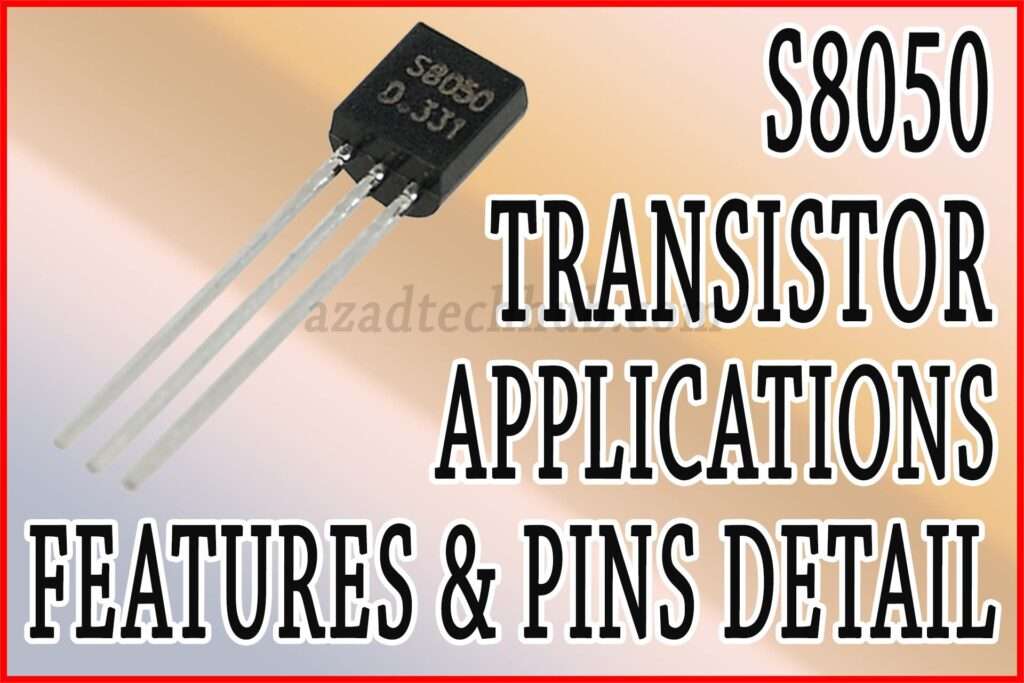S8050 NPN Transistor: A Comprehensive Overview
The S8050 NPN bipolar junction transistor (BJT) is known for its versatility and reliability. As an NPN transistor, it is commonly used for small-signal amplification and switching applications in various electronic circuits.
Read More

Let’s delve into the features, characteristics, technical specifications, and applications of the S8050 NPN transistor.
Features of S8050 NPN Transistor
NPN Transistor: The S8050 is an NPN transistor, which means it operates with a positive voltage at the collector concerning the emitter. This configuration allows it to amplify and control current flow effectively.
Package Type: The S8050 typically comes in a small SOT-23 surface mount package, making it suitable for modern electronics manufacturing processes and space-constrained applications.
Amplification: The S8050 NPN transistor has a high current gain, known as the hFE or DC current gain. This feature enables it to amplify weak input signals with a relatively small base current.
Switching Speed: With a moderate transition frequency (fT) and low switching times, the S8050 is well-suited for switching applications, allowing it to turn on and off rapidly.
Versatility: The S8050 NPN transistor’s versatile nature makes it an essential component in various electronic circuits, ranging from audio amplifiers to voltage regulators.
Characteristics of S8050 NPN Transistor
Collector-Emitter Voltage (VCEO): The S8050 NPN transistor typically has a maximum collector-emitter voltage rating of 40V, which specifies the maximum voltage it can withstand when the collector and emitter are reverse-biased.
Collector-Base Voltage (VCBO): The maximum collector-base voltage for the S8050 is around 60V, indicating the highest voltage it can withstand between the collector and base when the emitter is open-circuited.
Emitter-Base Voltage (VEBO): The maximum emitter-base voltage is approximately 5V, signifying the highest voltage the transistor can endure between the emitter and base when the collector is open.
Collector Current (IC): The S8050 NPN transistor can handle a maximum continuous collector current of 700mA. This rating defines its current-carrying capacity.
Power Dissipation (Ptot): The S8050 can dissipate a maximum power of 625mW, which is the maximum amount of power it can handle without exceeding its temperature limits.
Technical Specifications
- Package Type: SOT-23
- Maximum Collector-Emitter Voltage (VCEO): 40V
- Maximum Collector-Base Voltage (VCBO): 60V
- Maximum Emitter-Base Voltage (VEBO): 5V
- Maximum Collector Current (IC): 700mA
- Power Dissipation (Ptot): 625mW
- Transition Frequency (fT): Approximately 150MHz
- DC Current Gain (hFE): Typically ranges from 100 to 600
Applications S8050 NPN Transistor
Amplifiers: The S8050 NPN transistor is commonly used in audio amplifiers, signal amplifiers, and voltage amplifiers due to its high gain and amplification capabilities.
Switching Circuits: Its fast switching speed and moderate power handling make the S8050 suitable for various switching applications in digital logic circuits.
Voltage Regulation: The S8050 can be used in voltage regulator circuits to stabilize output voltages in power supplies.
Oscillators: It can be utilized in oscillator circuits to generate stable and low-frequency signals.
Sensor Interface: The S8050 acts as an interface between sensors and microcontrollers, converting weak sensor signals into usable voltage levels.
LED Drivers: Due to its ability to control current flow, the S8050 is used in LED driver circuits for controlling the brightness of LEDs.
In conclusion, the S8050 NPN transistor is a versatile and widely used component in electronics, with applications ranging from amplification and switching to voltage regulation and LED control. Its compact size, moderate power handling, and high current gain make it suitable for various low-power electronic circuits.
Designers and hobbyists can confidently incorporate the S8050 NPN transistor into their projects, knowing it offers reliable performance and versatility.
Related Posts:
- Floating Gate Transistor: Best Features & Applications
- Transistor S8050 Equivalent: Important Replacements
- S8050 Transistor: Best Functions, Specifications, and Applications
- Transistors BC547: Important Guide to Pinout
- C1815 Datasheet: Important Features to Know About
- 2N3904 Pinout, Datasheet and Equivalent Transistor
Subscribe to our Newsletter “Electrical Insights Daily” to get the latest updates in Electrical Engineering. You can also Follow us LinkedIn and Facebook to see our latest posts on Electrical Engineering Topics.
